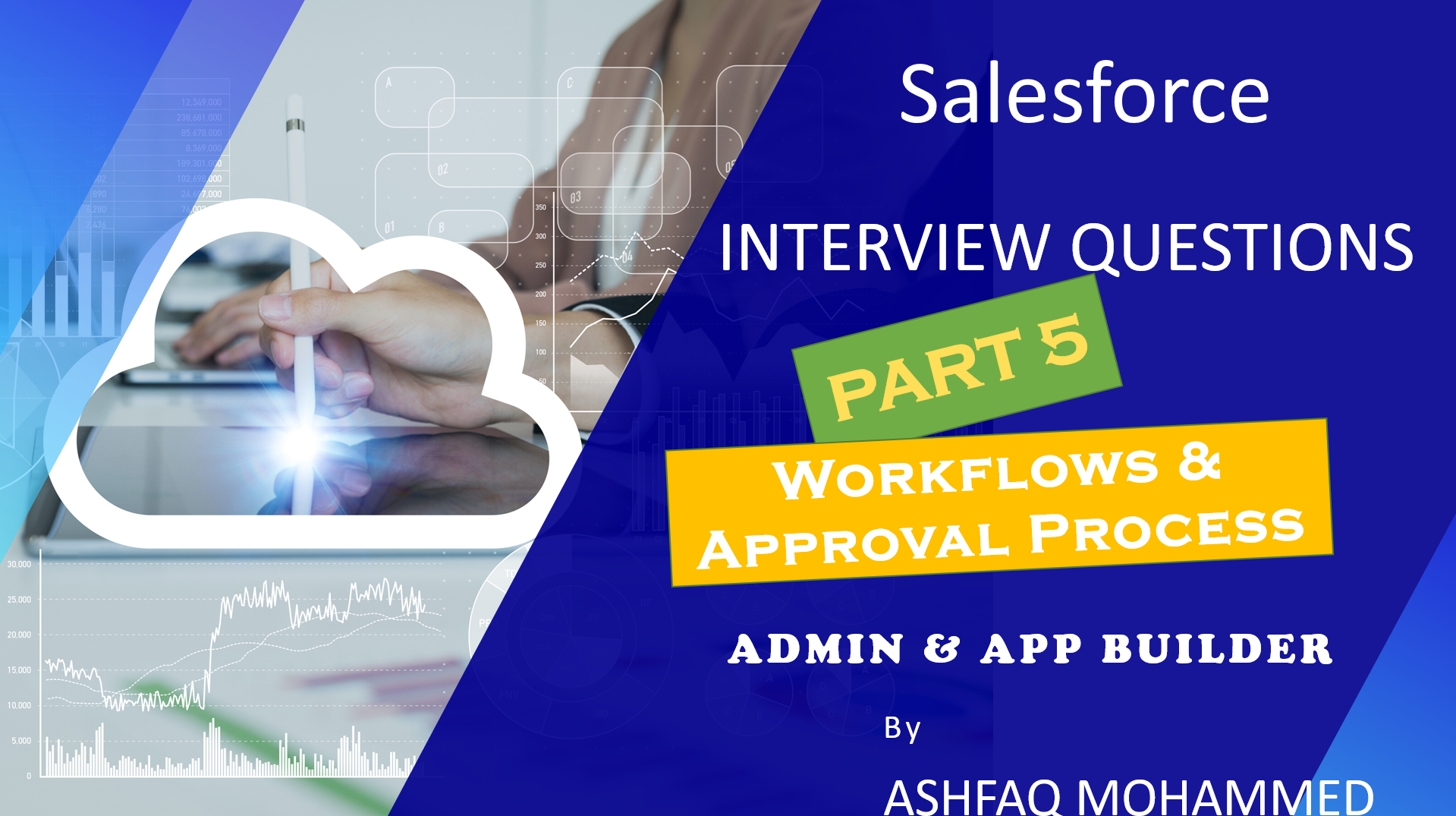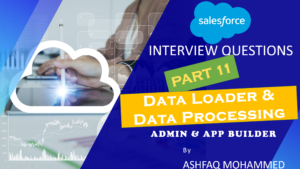Salesforce Admin Interview Questions – Workflows & Approval Process
Workflows & Approval Process
Table of Contents
96. What are the different automation tools available in salesforce?
Answer :
- Workflows
- Approval Process
- Process Builder
- Flow Builder
97. What are workflows?
Answer
Workflow allows us to automate the organizations business processes quickly without writing any code with the following four actions.
- Task – a task can be created
- Email alert – An email can be sent
- Field Update – To update the field
- Outbound Message – to send outbound message or data to an external system.
98. In which order individual actions and types of actions are executed in workflow?
Answer :
Execution of workflow does not guarantee the order in which individual actions are executed. However, field update actions are executed first, followed by other actions.
99. What are outbound messages? Or How can we send a message or data using outbound messages?
Answer :
- Outbound messages use the Endpoint URL, which will be provided by other systems (like SAP or Oracle, etc..).
- Endpoint URL allows us to send data from salesforce to other systems.
- In the outbound message, we can select which fields we want to send.
100. How many different types of email templates we can use in workflow email alert?
Answer :
- Text
- HTML (using Letterhead)
- Custom (without using Letterhead)
- Visualforce

101. In the workflow field update, can we update the related object fields, or can we update the cross object fields?
Answer :
Yes, we can update the related object field or cross object fields in workflow field update but only from child to parent update is possible not the other way.

102. In workflow field update can we update the related object fields or can we update the cross object fields?
Answer :
Yes we can update the related object field or cross object fields in workflow field update but only from child to parent update is possible not the other way.
103. What if we want to do field update from parent to child?
Answer :
We can use process builder to achieve it, and process builder can update a field from parent to child and child to parent.

104. What are the different evaluation criteria we have in workflows?
Answer :
- Created
- Created, and every time it is edited
- Created, and any time it is edited to subsequently meet criteria.

105. What is the difference between 2nd and 3rd evaluation criteria?
Answer :
- Created, and every time it is edited: With this option, the workflow rule run every time a record is edited as long as records meet the rule criteria.
- Created, and any time it is edited to subsequently meet criteria: With this option, the workflow rule only runs if the record is changed from not meeting the rule criteria to meeting the rule criteria.
106. What are the different options we have in workflow rule criteria?
Answer :
- Criteria are met
- Formula evaluates to true

107. What if we neither have any criteria to meet nor any formula to evaluate, then how can we skip the rule criteria as it is mandatory field?
Answer :
We can select the “formula evaluates to true” option and in the formula enter “true.”

108. Can we create more than one workflow for an object?
Answer :
Yes, we can create more than one workflow for an object.
109. How can we view or monitor pending time-based workflow action?
Answer :
Goto Setup → Monitoring → Time-Based Workflow. We will see all the pending time-based workflow action.

110. Can we delete the pending time-based workflow actions?
Answer :
Yes, we can delete pending time-based workflow action. Goto setup → Monitoring → Time-Based Workflow, select any pending action we want to delete and click on the delete button.
111. What happens to the workflow rules when the object is deleted?
Answer :
Standard objects cannot be deleted, and when the custom object is deleted, then workflow rule for that object will automatically get deleted.
112. What happens when a time-dependent action is in a queue and waiting for the right time to trigger and in between we edited the record and changed the condition after which original record no longer meets the triggering criteria?
Answer :
In this scenario, the time-dependent action will automatically leave the queue. Alternatively, it will be automatically removed from the queue.
113. What is the order in which salesforce processes rules?
Answer :
- Validation rules
- Assignment rules
- Auto-response rules
- Workflow rules (with immediate actions)
- Escalation rules
114. Can we create workflow rules on the user object, and what are its limitations?
Answer :
Yes, we can create workflow rules on the user object, and the limitation is that it does not support the creation of the task.
Example: Send Welcome email messages with training resources to newly created users by using email alert actions.
115. What is an approval process and how it is different from workflow rule?
Answer :
- An approval process is also used to automate the business process similar to workflow rules. Also, it takes automation one step further; it will allow us to specify a sequence of steps that are required to approve a record.
- All the workflow action like creating a task, update field, sending email and outbound message are supported in the approval process.
116. Give an example of where we will implement the approval process?
Answer :
If an employee has to apply leave which should be approved by his manager or HR Manager, then in this case approval process can be used. This can be achieved by using only a single step approval process.
117. Give a complex example where we will implement a multi-step approval process?
Answer :
A multi-step approval process is used in a scenario where we need more than one person’s approval.
Example: In a sales process when we are sending Quote/Proposal to the customer with 30% discount then only one manager should approve. Also, if we are giving more than a 30% discount, then the manager and senior manager should approve one after other. This can be achieved using a multi-step approval process.
118. How can a user submit the records for approval?
Answer :
- As soon as the approval process setup on a particular object, a “Submit for Approval” button will be displayed on the records page. If this button is not displayed, then we can get it from the page layout.
- Apart from the button, there is a related list “Approval History” displayed on the records page layout with “Submit for approval” button on it.
- We can use any of these buttons to submit for approval.

119. Can the user recall the submitted approval record?
Answer :
Yes, we can configure this in the approval process. If “Allow submitter to recall approval request” is selected, then the user will be able to recall the approval process.

120. Can the approver re-assign the record to another user for approval?
Answer :
Yes, the original user can re-assign the record to another user for approval.
121. What is delegated user in salesforce?
Answer :
- Delegated user/approver is an alternate approver for any user.
- The delegated user field is available in the user object if this field is populated and the option “The approver’s delegate may also approve this request” is selected in the approval process then actual user and the delegated user both will receive the notification to approve the request.
- Delegate user cannot reassign the approval request; they can only approve or reject.

122. Sometimes when we click “submit for approval” button, then we get the below error. What is the reason?
Unable to Submit for Approval “This record does not meet the entry criteria or initial submitters of any active approval processes. Please contact your administrator for assistance“.
Answer :
Every Approval process has entry criteria. Which means when we submit any record, it should meet that criteria or condition to enter into the approval process. If the criteria do not meet, then only we get this error.
Example: If the approval entry criteria say if status == New or Draft then only enter into the approval process. So if the status is anything else than New or Draft, then we will get this error.

123. Can the users edit the records while it is pending approval?
Answer :
NO. The approval process will lock the records so that users cannot edit it while it is pending approval. Only the administrator or approvers can edit the records during the approval process.
124. Can a record be automatically approved, rejected or skipped based on specific criteria?
Answer :
Yes, we can set entry criteria for each step of process and configure approval process in such a way that it can approve, reject or skip the approval process if a record does not meet the criteria.
For example, all the expenses submitted by the user with an amount not exceeding or less than $15 are automatically approved.
125. What are the different wizards we have in salesforce approval process, and which one should the user use?
Answer :
We have two wizards in the salesforce approval process
- Jump Start Wizard
- Standard Wizard
- When we create an approval process which uses a single step, then use the jump start wizard. This wizard will choose some default options for us. Whereas when we create a more complex approval process, then we can use a standard wizard.

126. Can the user approve the approval request via email?
Answer :
Yes, user can respond to approval request email and type APPROVE or REJECT and send the email. It will automatically approve or reject based on the response.
To enable email response goto setup → Search Process Automation Settings and select “Enable email approval response.”
127. Is it possible to trigger the approval process without the user clicking on the “Submit for approval” button?
Answer :
Yes, we can automatically trigger the approval process without users intervention. This can be achieved using a trigger. (Development effort is required to achieve this requirement).
128. Apart from Assigned approver and delegated approver who else can approve the approval request?
Answer :
Users with “Modify All Data” or “Modify All” for an object can respond to approval requests, even if they are not designated approver.




